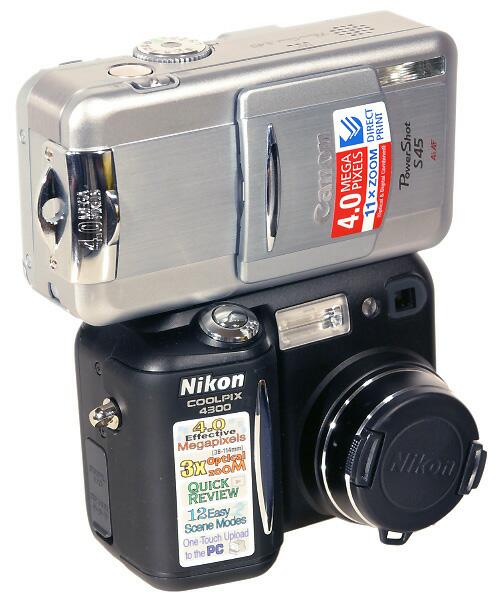
Although the cameras are of the same class and price range, they are
actually very different.
Manufacturers keep on making every attempt in adding attractiveness
for their products for consumers. Attractiveness is a vague concept. As
you know, tastes differ, but no one likes to stuff their pockets with extra
weight, that is why the tendency toward a compact size is common for all
manufactures. Regarding photo cameras, it means to get a minimal size and
weight with the frame format and lens focal length remaining unchanged.
But when it's impossible to reduce the dimensions further with the same
frame size, it gives birth to another class of cameras. Miniaturization
can be an endless process, but some models are already so miniature that
one has to be a Lilliputian to be able to shoot with them. An excellent
example of miniaturization is Novelty
Subminiature Hit Camera.
But the main purpose of cameras is taking shots, and such extremes are
not frequent. There is no a simple answer to what a compact camera should
look like. There are miniature copies of big cameras (Narciss,
Zenit-surprize), and there are quite different midgets a number of
which follow the design of Minox
made in 1936 in Riga. A concept of a classic compact camera is often associated
with this solution and the like (Minolta
16, Kiev-Vega,
Kiev-30). When choosing a camera, your expectations brought up by fashion
and what you saw before are often determining. A camera must be an extension
of your hands for proper shooting, which can hardly be expected from a
device that you don't know how to hold. So, those who expect a small copy
of a big camera should address Nikon, and those who prefer the classic
style of the Riga's heritage should go with Canon.
A distinguishing feature of compact cameras as a class is that most
of their extended functions are meant for a narrow range of users. The
most important thing is that they can be easily fished out of pockets,
do not weigh pockets down, and be ready in no time for shooting in the
auto mode. Their basic mode is shooting without long preparations.
The automatic system of both cameras work well as I can judge as a man
dealing mostly with manual settings. That is why the recommendations will
be simple for most users: choose a camera the appearance of which looks
better for you, which works as an extension of your hands and which is
going to tear your pockets least of all.
The further information is for those who like to go into more details
in this matter. Nikon reminds a big camera and supports tele and wide-angle
converters with UR-E7 adapter ring. The downside of this camera is perfectly
explained in its description.
Comments on the minimal aperture.
COOLPIX 4300 photo camera uses a filter in case of the minimal aperture
which adjusts a light flow getting inside. That is why the minimal aperture
can provide smaller depth-of-field than expected from the aperture shown
on the monitor.
Taking into account that the camera has only two aperture values specified,
the aperture adjustment mechanism is not provided. And if there is too much light,
it uses a neutral filter. Such cases were known before in the history of photography,
but, for example, in case of the Rubinar lens
which has no changeable aperture neutral filters are called neutral filters but
not aperture. I don't have strong objections to such wording, here brevity is
more important especially because the instruction gives the explanation. But such
wording in the specification is very incorrect. I have to admit that culture and
quality are far different things. This is the case when I want explanation why
they did that, not satisfaction. Photography is used not only for image registration.
This is also a good aid in learning physics, but the company doesn't accept this
good educational aim; in contrast, they confuse consumers this way.
It's clear that such approach wouldn't provide for aperture priority
or shutter priority; there is only a manual mode when you can set exposure
and the filter, and a fully automatic mode. Maybe I'm wrong, and this is
going to be a technological breakthrough. I have recently heard that there
is a way to increase the DOF of digital cameras with the full aperture
and, the filter is probably only an intermediate stage (CDM
Optics).
For those who don't know much in physics there are special modes like
Portrait, Sport, Night Shooting etc. (like in Smena-8 Symbol). After Smena-6
which I used in 60s, I got an impression that manufacturers wanted to develop
an inferiority complex in users supposing that it's impossible for them
to get the idea of the geometrical optics even on the simplest level. At
the same time I think that quality of the cameras now corresponds to a
supposed user's level. Let's calculate the constant aperture using the
DOF calculation
program when there is no lack of light. At the focal length of 20 mm
the hyperfocal length for Nikon's camera makes 10 m. And the image will
be sharp from 5 m to infinity.
The aperture of Canon's camera can be reduced to F:8. The hyperfocal
length in this case will be 5 m and the image will be sharp from 2.5 m
to infinity. So, if you shoot landscape with the forefront, the forefront
must be at least 2 meters further because of the neutral filter's focuses.
Note that the cameras have almost identical lenses. At the maximum focal
length the difference in the contrast-transfer functions (CTF) of Nikon,
Canon (the lens is fully open, F:4.9 aperture) and Casio QV 4000 (F:5.6
aperture) is within the inaccuracy of measurements. So, the compact
size didn't affect much the quality, but the reduced maximum lens diameter
made the aperture ratio smaller four times as compared to full-size models
such as Casio QW-4000 and Canon G2. Since this Nikon's camera is a small
copy of a big one, remember to take off the cap from the lens, otherwise
you can damage the drive. It seems that the cameras are equipped with Sony's
matrix 1/1.8" (i.e. of the same size as of senior model). But the filtering
systems are different: Canon use GRGB and Nikon - CYGM. The spectrum of
the halogen lamp obtained with a gitter demonstrates that the results are
very similar in the RGB space, and the difference is noticeable only in
the shape of the curves on the diagram of signal amplitude vs. wavelength
in the blue channel.

Canon PowerShot S45

Nikon COOLPIX 4300
Casio QV4000 seems to have the matrix identical to Canon, with the same
filtering system and a similar shape of the spectral sensitivity curves.

Casio QV4000
As to Canon's model, this is a full-featured camera (modernization of S40)
which supports aperture priority, shutter priority and a manual mode. Its distinguishing
feature is recording in the RAW format and shooting control through PC. But the
camera is compact, and it has no standard means for attaching optical converters.
Specification
| |
Canon PowerShot S45 |
Nikon COOLPIX 4300 |
| Weight |
323 g (260 g camera only) |
286 g |
| Dimensions |
112 x 58 x 42 mm |
95 x 69 x 52 mm |
| Frame size (max.) |
2272 x 1704 |
2272 x 1704 |
| Recording format |
JPEG, RAW |
JPEG, TIFF |
| Matrix |
CCD 1/1.8" GRGB ; 4.1 Mp |
CCD 1/1.8" CYGM; 4.1 Mp |
| Lens |
7.1 - 21.3 mm
(35 - 105 mm in 35mm equivalent) |
8 - 24 mm
(38 - 114 mm in 35mm equivalent) |
| Aperture |
F:2.8 - F:4.9 / F:8 |
F:2.8/F:7.6, F:4.9/F:13.4 |
| Exposure |
15 s - 1/1500 s |
B, 8 s - 1/1000 s |
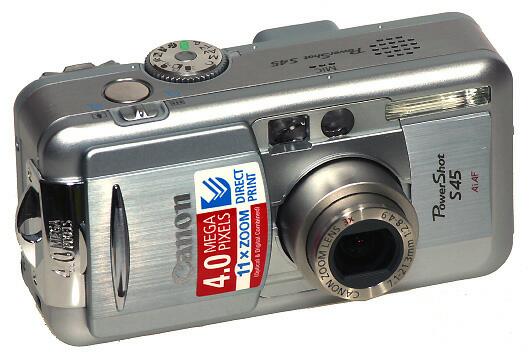
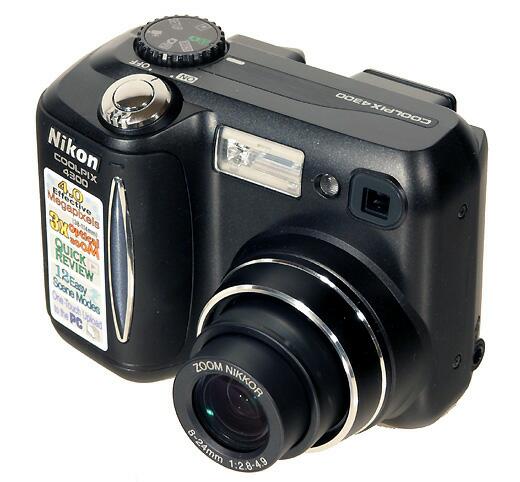
| LCD display |
1.8"; 118000 pixels |
1.5"; 110000 pixels |
| Manual focusing |
yes |
yes |
| Focusing range |
from 10 cm |
from 4 cm |
| Exposure priority |
yes |
no |
| Aperture priority |
yes |
no |
| Manual adjustment of exposure and aperture |
yes |
yes |
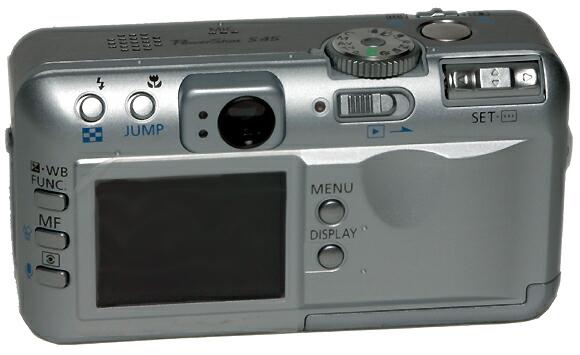

| Memory |
Compact Flash (Type I or II) |
Compact Flash (Type I only) |
| Power supply |
NB-2L Li-Ion
(7.4 V; 570mAh) |
EN-EL1 Li-Ion rechargeable battery (7.4 V; 680mAh) or 2CR5
battery |
| Charger |
CB-2LT |
MH-51 |
| Video-out |
PAL or NTSC |
PAL or NTSC |
| PC connection |
USB |
USB |
| Sound |
yes |
no |

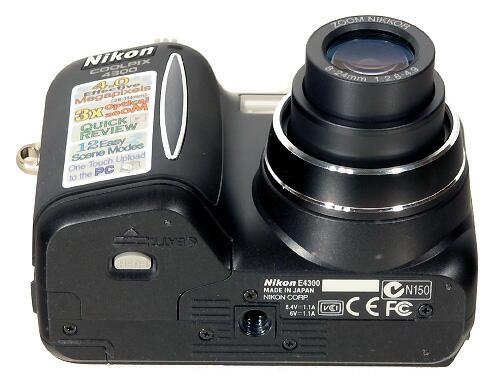
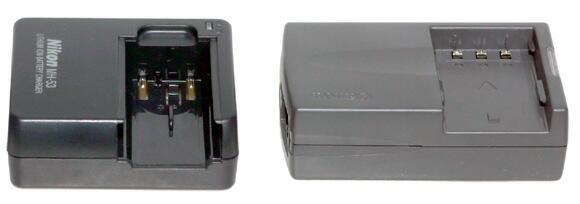
Nikon MH-51 and Canon CB-2LT
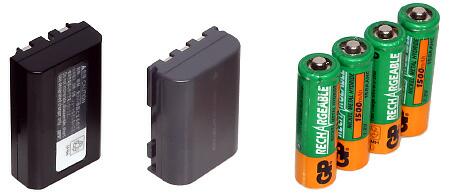
Nikon EN-EL1 and Canon NB-2L. The AA batteries are shown so that
you can estimate the size.
Menu
I think that it's easy to get used to both menus. That is why you should
choose the one you like more. I tried to place similar menu options next
to each other, but sometimes it was impossible as the logic of the menu
items differs.
|
Canon PowerShot S45
|
Nikon COOLPIX 4300
|

|

|
|
Information displayed during shooting for manual focusing. Canon displays distance
in meters, but it's to be taken as reference points, Nikon has only symbolic pictures
for extreme positions: mountains on the horizon and a flower in the foreground.
|
| |
|

|
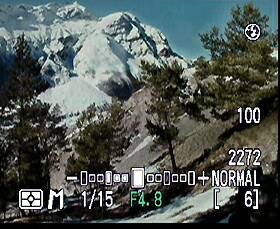
|
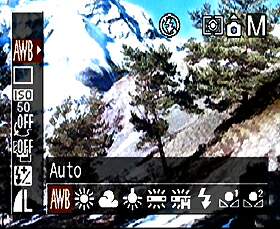
|

|
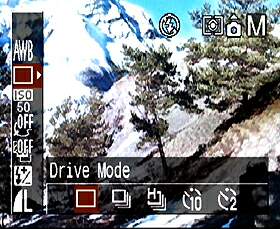
|

|

|
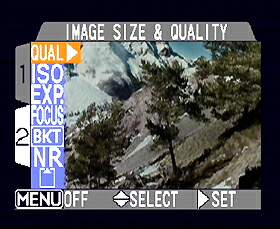
|

|

|

|

|

|

|

|
|

|

|
| |
|

|
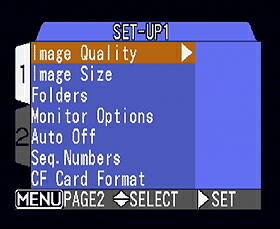
|

|

|

|

|

|

|

|

|

|

|

|

|

|

|

|

|
Photos
|
Canon PowerShot S45
|
Nikon COOLPIX 4300
|

|

|
|
F=7 mm; !/320 s ; F:7.1
|
F=8 mm; !/247 s ; F:7.6
|
|
Click on the picture to see the original shot.
|

|
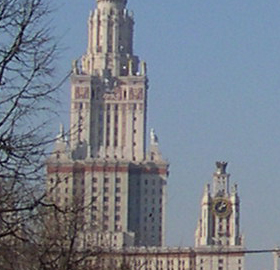
|
|
Fragment. F=7 mm; !/1000 s; F:4.5
|
Fragment. F=8 mm; !/315 s; F:7.6
|
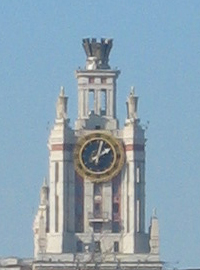
|
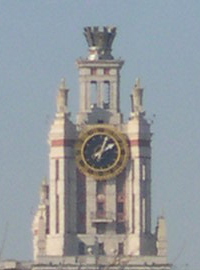
|
|
Fragment. F=21 mm; !/640 s; F:4.9
|
Fragment. F=24 mm; !/92 s; F:13.4
|
Conclusion
We have compared two digital cameras of the same price range. The automatic
systems work pretty well. Although Nikon's camera looks similar to its
bigger brother, it is meant for fans of Point-&-Shoot devices who,
however, conceal this fact. But it can be used with standard converters
and has a smaller focusing length in the Macro mode. Canon keeps the traditions
of both compact film cameras and its earlier digital models. The improvements
are made mostly in the electronic section. The camera can't be used together
with additional external devices but it doesn't yield to some bigger models
in handling.
Write a comment below. No registration needed!












